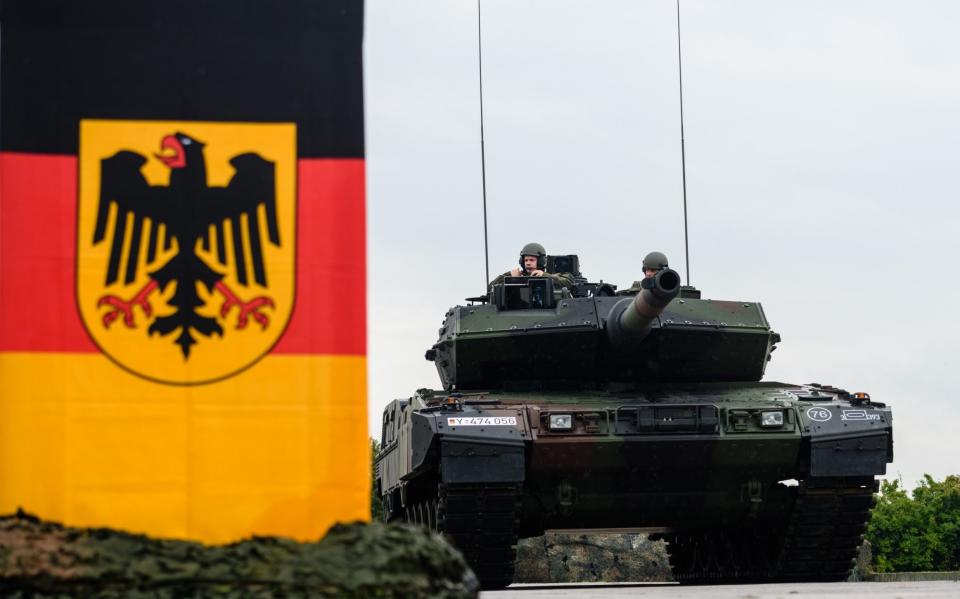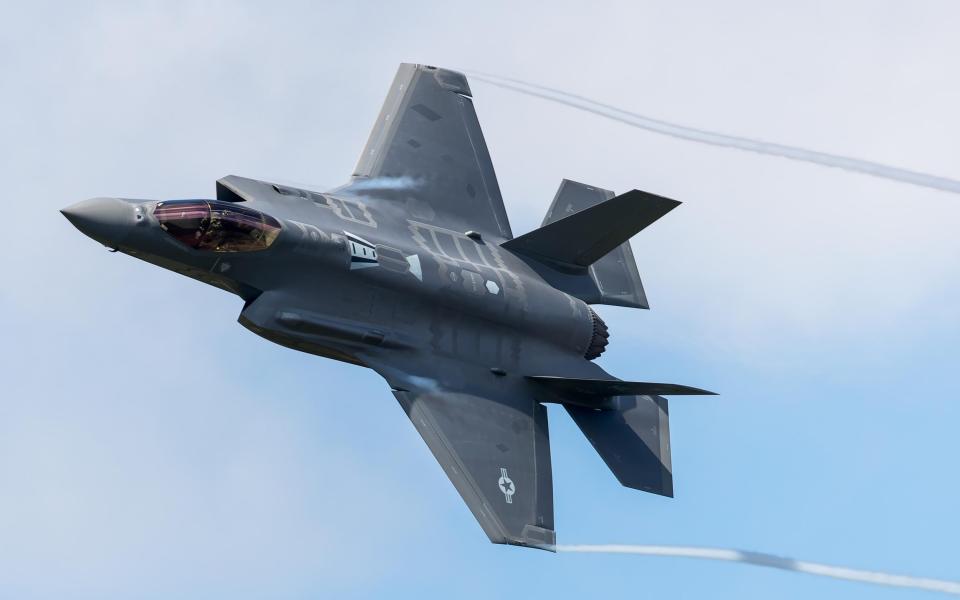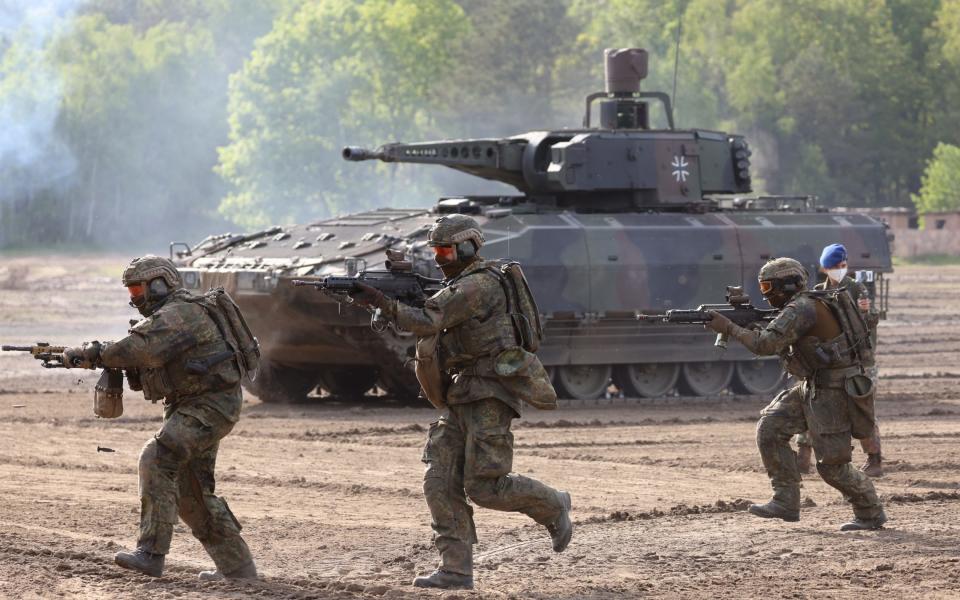'National laughing stock': How Germany is spending €100bn to transform its military

Germany's armed forces reached rock-bottom when forced to use broomsticks as guns in a Nato training exercise amid a dire shortage of equipment.
The troops were dubbed a "national laughing stock" after a leaked internal army report in 2014 described soldiers resorting to painting broomsticks black before attaching them to army vehicles, to simulate missing arms.
The incident came out at a similar time a German audit report also found the military was without sufficient supplies of spare parts and personnel: a result of long neglect.
Years later in 2018, President Trump lambasted Angela Merkel for failing to deliver on the Nato defence spending target of 2pc of GDP. Ursula von der Leyen, then Germany's defence minister, said it would reach only 1.5pc by 2025.
Now, Germany seems to have changed its attitude under Chancellor Olaf Scholz, who has pledged to spend €100bn (£85bn) to boost domestic military capabilities and lift annual spending above 2pc. Defence analysts expect the money to be spread over up to 10 years.
In the first demonstration of its commitment to build a credible defence force, Germany last week announced an order for nuclear-capable F-35 fighter jets from US defence giant Lockheed Martin. The jets will replace some of Berlin’s Tornado planes which have been in service for more than 40 years.

It comes as Vladimir Putin's invasion of Ukraine forces European nations to rethink their military resources. For Germany, it begs the question of whether the money will be used to return the country to its former military powerhouse status - having been a pacifist nation following the Nazi atrocities – or rely on overseas suppliers.
Announcing the pledge, Scholz said: "In attacking Ukraine, Putin does not just want to eradicate a country from the world map, he is destroying the European security structure.
“It is clear that we must invest significantly more in the security of our country, in order to protect our freedom and democracy.”
As the country tees up orders, its shopping list is likely to be filled with new types of weapons – with much made domestically.
“There has been a big change in how European countries are now thinking about defence,” says Andy Thomis, chief executive of London-listed defence and security company Cohort.
“They are moving away from thoughts of defence in the context of insurgent-type forces such as the Taliban, or paramilitary forces, who have very aggressive tactics but quite basic technology.
“Now they suddenly have to think about taking on rivals with comparable levels of technology, and well-organised armed forces. People are now looking at adversaries who are near peers in terms of technology.”
Analysts predict Berlin will focus much of its investment on domestic companies such as Düsseldorf-based arms manufacturer Rheinmetall and Nuremberg-based Diehl Group, which makes aircrafts and parts. Defence analyst Francis Tusa predicts up to 80pc of the spending will be reserved for German corporations.
“The Germans will have to bend over backwards to show this money is going to German companies. They've said they're buying a new batch of the Puma infantry combat vehicle for about €3bn,” he says.
“Rheinmetall has been exporting its goods from its subsidiaries, but it will take time to ramp up. If you've scaled your domestic production for a low level, it takes you some time to do that. But Rheinmetall is an incredibly agile company and it's very aggressive.”

The remaining purchases, such as tank ammunition and new fighter jets, are likely to be from manufacturers in the US, France and Britain. Tusa points to European missile maker MBDA as one company that could secure more business. Its Meteor air-to-air missile was already tested by Germany last year.
He believes there will also be a big focus on maintaining the equipment Germany already has, and retooling it to prepare for active use.
"They need to go back to their maintenance contractors and say: you know we were happy with having only six of these helicopters being available? We actually need twenty-six available," says Tusa.
Currently, the German army has 701 aircraft, six submarines, 1,340 tanks and personnel carriers and around 54,000 soldiers.
Berlin’s decision to ramp up spending after years of ambivalence represents a “clear signal”, argues Thomis.
"It's very clear that Germany recognises that defence, particularly in central and eastern Europe, is more important than ever. Both in terms of practical purposes as threat emerges, but also to send a clear signal that the country is prepared to defend itself. And I'm pretty sure other European countries will be thinking along the same lines,” he says.
"All of this is a clear mark of just how disruptive the events of these last few weeks have been."
Berlin’s military spending stagnated for some time and even fell as a proportion of GDP during Merkel’s third term as Chancellor, before both ramped up in 2019 as a result of international pressure.
Its long lack of aggression in expanding its military budget is not only a result of its past, according to Tusa, but also for economic reasons.
"During the Cold War, German defence spending was quite high, because they understood that they couldn't rely on everyone else," he says. "But after the fall of the Berlin Wall, they just cut everything.”
“Ultimately they just wanted to spend more on social programmes. That was a choice."
As Russian missiles reap devastation on cities in Ukraine, Germany is now taking a very different path.

 Yahoo Finance
Yahoo Finance 